40°57′29″N 100°17′28″E / 40.95806°N 100.29111°E
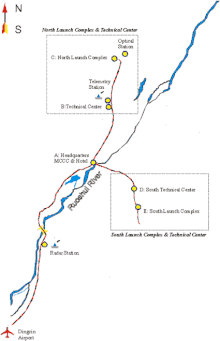 Map of the chinese Jiuquan Satellite Launch Center | |||||||||||||||||||||||||
| Location | Ejin, Alxa, Inner Mongolia | ||||||||||||||||||||||||
|---|---|---|---|---|---|---|---|---|---|---|---|---|---|---|---|---|---|---|---|---|---|---|---|---|---|
| Coordinates | 40°57′29″N 100°17′28″E / 40.95806°N 100.29111°E | ||||||||||||||||||||||||
| Operator | CASC | ||||||||||||||||||||||||
| Total launches | 132 | ||||||||||||||||||||||||
| Launch pad(s) | Two | ||||||||||||||||||||||||
| Launch history | |||||||||||||||||||||||||
| Status | Active | ||||||||||||||||||||||||
| |||||||||||||||||||||||||
| Jiuquan Satellite Launch Center | |||||||||
|---|---|---|---|---|---|---|---|---|---|
| Simplified Chinese | 酒泉卫星发射中心 | ||||||||
| Traditional Chinese | 酒泉衛星發射中心 | ||||||||
| |||||||||
Jiuquan Satellite Launch Center (JSLC; Chinese: 酒泉卫星发射中心; pinyin: Jiǔquán Wèixīng Fāshè Zhōngxīn also known as Shuangchengzi Missile Test Center; Launch Complex B2; formally Northwest Comprehensive Missile Testing Facility (西北综合导弹试验基地); Base 20; 63600 Unit)[1] is a Chinese space vehicle launch facility (spaceport) located in the Gobi Desert, Inner Mongolia. It is part of the Dongfeng Aerospace City (Base 10). Although the facility is geographically located within Ejin Banner of Inner Mongolia's Alxa League, it is named after the nearest city, Jiuquan in Gansu Province. The launch center straddles both sides of the Ruo Shui river.[2]
History
It was founded in 1958, the first of China's four spaceports. As with all Chinese launch facilities, it is remote and generally closed to foreigners.
The Satellite Launch Center is a part of Dongfeng Space City (东风航天城), also known as Base 10 (十号基地) or Dongfeng base (东风基地). The Dongfeng site also includes People's Liberation Army Air Force (PLAAF) test flight facilities, a space museum and a so-called martyr's cemetery (东风烈士陵园).[3]
JSLC is usually used to launch vehicles into lower and medium orbits with large orbital inclination angles, as well as testing medium to long-range missiles. Its facilities are state of the art and provide support to every phase of a satellite launch campaign. The site includes the Technical Center, the Launch Complex, the Launch Control Center, the Mission Command and Control Center and various other logistical support systems.
The center covers 2800 km2 and may have housing for as many as 20,000 people. The facilities and launch support equipment were likely modelled on Soviet counterparts and the Soviet Union likely provided technical support to Jiuquan.
Jiuquan Satellite Launch Center was expanded during the Third Front campaign to develop basic industry and national defense industry in China's rugged interior to prepare for potential invasion by the Soviet Union or the United States.[4]: 218
The launch center has been the focus of many of China's ventures into space, including their first satellite Dong Fang Hong I in 1970,[5]: 218 and their first crewed space mission Shenzhou 5 on 15 October 2003. As of 2021, all Chinese crewed space flights, meaning all flights in the Shenzhou program including crewed flights to the Tiangong space station, have launched from Jiuquan.
In August 2016, China launched the first quantum communication satellite, the "Quantum Experiments at Space Scale", from the center.[6]
In August 2018, Chinese private rocket manufacturing startups i-Space and OneSpace launched sub-orbital rockets from the center.[7] On July 25, 2019, the first Chinese private orbital launch took place from Jiuquan as I-Space launched their Hyperbola-1 rocket.
Launch pads
The launch site comprises two launch complexes, each containing several launch locations. All the launch statistics reported below are up to date as of December 2023.
North Launch Complex
The North Launch Complex consists in two different launch areas, both currently inactive.
- Launch Area 2: used for both orbital launches and ballistic missile tests.
- LA-2A: used for launches of the DF-3 and DF-5 ballistic missiles and hosted the first Chinese orbital launches, carried out through the CZ-1 launch vehicle. It hasn't hosted orbital launch attempts since 1971. (41°18′32″N 100°18′59″E / 41.3088°N 100.3165°E)
- LA-2B: used for orbital launches of the CZ-2A, CZ-2C, CZ-2D and FB-1 launch vehicles. It has been last used in 1996. (41°18′22″N 100°18′48″E / 41.3061°N 100.3132°E)
- Launch Area 3: situated approximately 2.7 km south of Launch Area 2, used for launches of the DF-1, DF-2 and R-2 ballistic missiles.
- North pad (located at approximately 41°16′59″N 100°18′17″E / 41.2831°N 100.3047°E)
- South pad (located at approximately 41°16′49″N 100°18′16″E / 41.2804°N 100.3045°E )
South Launch Complex
The South Launch complex is currently active and consists in a main launch area used by CASC to handle the launches of several Long March vehicles and a variety of concrete pads for small rocket launches.
- Launch Area 4: it's situated approximately 37.9 km south of Launch Area 3.
- SLS-1 (LS-43/91): it has been used since 1999 for the launches of the crew-rated CZ-2F launcher and it's equipped with a nearby Vertical Assembly Facility. (40°57′38″N 100°17′53″E / 40.960671°N 100.298186°E)
- SLS-2 (LS-43/94): operational since 2003, it has been hosting launches of various medium-lift launch vehicles of the Long March family, including CZ-2C, CZ-2D, CZ-4B and CZ-4C. (40°57′28″N 100°17′27″E / 40.957893°N 100.290944°E)
- Commercial launch pads: situated in multiple locations south and east of Launch Area 4, they're used for small rocket launches of different government-owned and private companies.
- LS-95: consisting in two pads, it has hosted launches of the Long March 11, Kuaizhou, Jielong 1, OS-M1, Hyperbola-1 and Ceres-1 launch vehicles. The first launch, a test flight of the Kuaizhou-1 rocket, took place on 25 September 2013, while the last one was a Kuaizhou 1A launch on 11 January 2024.
- Pad A (40°58′11″N 100°20′38″E / 40.9698°N 100.3439°E), the most used, accounts for a total of 47 launch attempts
- Pad B (40°58′21″N 100°21′50″E / 40.9725°N 100.3639°E) hosted only 5 launches.
- LS-96: a single pad handled by the private company LandSpace for the launches of its Zhuque-2 launch vehicle. It has hosted 3 launches so far, two of which successful. (40°54′54″N 100°14′43″E / 40.9149°N 100.2454°E)
- LS-120: a single pad handled by the private company Space Pioneer for the launches if its Tianlong-2 launch vehicle. It has hosted only one successful launch as of today. (40°51′20″N 100°11′57″E / 40.8556°N 100.1992°E)
- LS-130: a single pad handled by the state-owned company CAS Space for the launches of their Kinetica 1 launch vehicle. It has hosted 2 successful launches as of today. (40°49′07″N 100°13′26″E / 40.8186°N 100.2240°E)
- LS-95: consisting in two pads, it has hosted launches of the Long March 11, Kuaizhou, Jielong 1, OS-M1, Hyperbola-1 and Ceres-1 launch vehicles. The first launch, a test flight of the Kuaizhou-1 rocket, took place on 25 September 2013, while the last one was a Kuaizhou 1A launch on 11 January 2024.
Image gallery
 KH-7 satellite image of the Shuang Cheng Tzu Missile Center A (Jiuquan Satellite Launch Centre) in 1967.
KH-7 satellite image of the Shuang Cheng Tzu Missile Center A (Jiuquan Satellite Launch Centre) in 1967.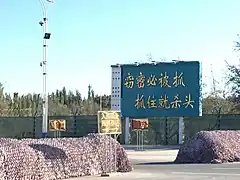 A warning board at the gate.
A warning board at the gate.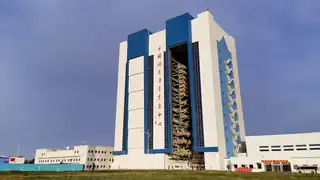 Launch Vehicle Vertical Assembly Building.
Launch Vehicle Vertical Assembly Building. Tower 1 and 2 behind a sign.
Tower 1 and 2 behind a sign. Launch tower.
Launch tower. Launch of LM-2D (VRSS-1 / Miranda).
Launch of LM-2D (VRSS-1 / Miranda).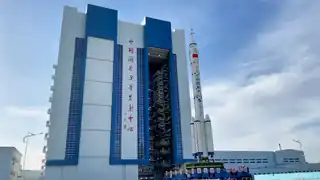 Roll out of CZ-2F (Shenzhou-12).
Roll out of CZ-2F (Shenzhou-12)..jpg.webp) Launch of CZ-2F(Shenzhou-12).
Launch of CZ-2F(Shenzhou-12).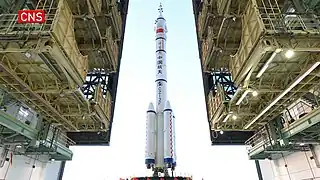 Roll out of CZ-2F (Shenzhou-13).
Roll out of CZ-2F (Shenzhou-13).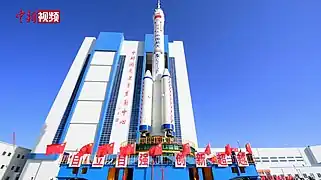 Roll out of CZ-2F (Shenzhou 14).
Roll out of CZ-2F (Shenzhou 14).
See also
References
- ↑ "Jiuquan Space Launch Center - Facilities - NTI". www.nti.org. Retrieved 21 January 2019.
- ↑ "This Military Base is Where China Blasts Humans into Space". Bloomberg.com.
- ↑ "航天科技游圣地——东风航天城 (The Jerusalem of the space tech journey-Dongfeng space city)" (in Chinese). 新华网内蒙古频道 (Xinhua network inner-Mongol channel). 5 December 2007. Archived from the original on 24 July 2009. Retrieved 7 May 2008.
- ↑ Meyskens, Covell F. (2020). Mao's Third Front: The Militarization of Cold War China. Cambridge, United Kingdom: Cambridge University Press. doi:10.1017/9781108784788. ISBN 978-1-108-78478-8. OCLC 1145096137. S2CID 218936313.
- ↑ Meyskens, Covell F. (2020). Mao's Third Front: The Militarization of Cold War China. Cambridge, United Kingdom: Cambridge University Press. doi:10.1017/9781108784788. ISBN 978-1-108-78478-8. OCLC 1145096137. S2CID 218936313.
- ↑ "China Launches Pioneering 'Hack-Proof' Quantum-Communications Satellite". space.com. Space.com. 16 August 2016. Retrieved 16 August 2016.
- ↑ Jones, Andrew (7 September 2018). "Chinese startups OneSpace, iSpace succeed with suborbital launches". Retrieved 10 September 2018.
External links
- Base 20 Jiuquan Space Facility on GlobalSecurity.org